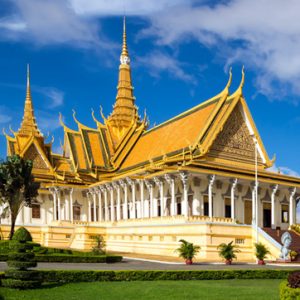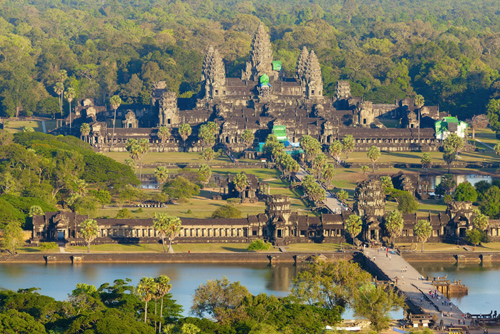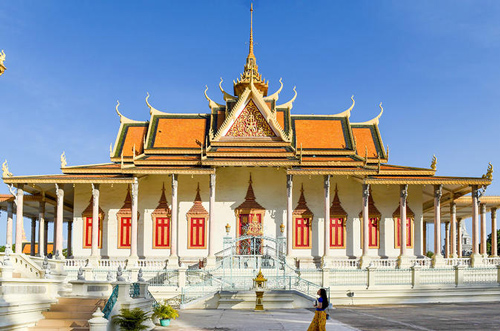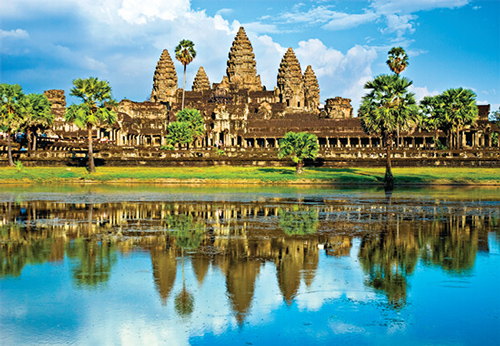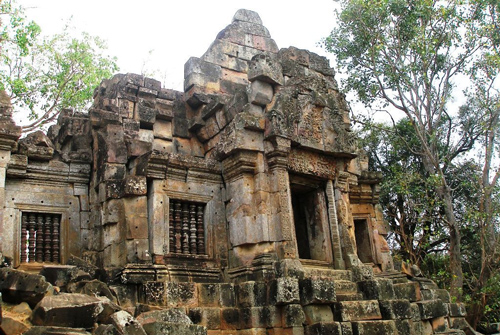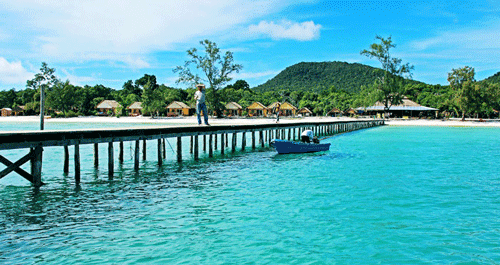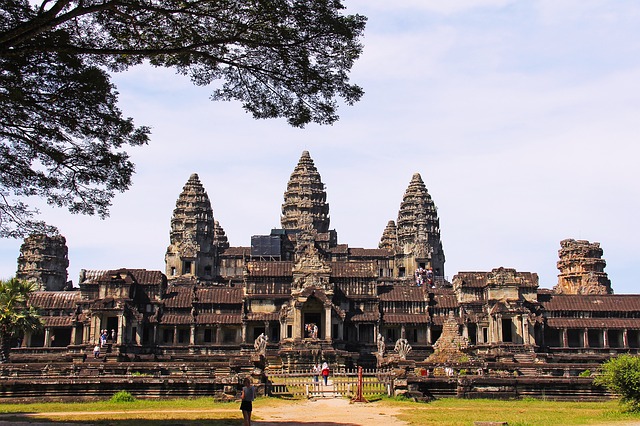Rainy season in Cambodia makes this country fresher and greener compared to the high season from October to April. Travelers will be rewarded with fewer crowds, lower prices, and more laid-back atmosphere during this time of the year.
Rainy Season in Cambodia

- Angkor Wat
Rainy season in Cambodia lasts from May to September with the average temperature of 28 – 30 degrees Celsius. The early months of rainy season, which are May and June, are the hottest months when the temperature can reach 32 to 35 degrees Celsius. During this season, the far north (Mondulkiri and Ratanakiri) and the northern coast like Kep Province are inaccessible from late July to September due to heavy downpours. However, short rainfalls from May to July bring a tranquil greenness to Angkor Wat and a stunning scene of ‘floating’ houses in Tonle Sap, so do not let the rains stop you from a tour to Cambodia.
Remember to watch the weather forecast before traveling to this country. Plus, do not forget to bring umbrellas, raincoats, and insect repellent.
Events and Festivals during Rainy Season in Cambodia
1. Royal Ploughing Ceremony (May)

- Royal Ploughing Ceremony in Cambodia
The Royal Ploughing Ceremony, also known as ‘Preah Reach Pithi Bonn Chrot Preah Neangkol’, is a long-lasting ceremony of the country. This is an ancient ritual which is traditionally held after the full moon day of Pisak (the 6th month of Khmer calendar), which marks the start of the rice-growing season. Since it is a time of the year when the dry season ends and the rainy season begins, peasants start preparing their farming activities for new crops. This ceremony is celebrated outside the Royal Palace in Phnom Penh, as well as in Siem Reap.
2. King Norodom Sihamoni’s Birthday (13 – 15 May)

- King Norodom Sihamoni
A three-day holiday is held every year to celebrate the Royal Birthday of Norodom Sihamoni. Born on May 14, 1953, he has been the King of Cambodia since October 29, 2004. On October 14, 2004, he was selected by 9 members of the Council, making Cambodia one of the few elected monarchies of the world. On this day, the King makes offerings to Buddhist monks and the disadvantaged around the country. The country is decorated with pictures of the King and national flags. Celebrations are organized inside the Royal Palace and a firework display is held on the nearby Tonle Sap Lake.
3. National Day of Remembrance (May 20)
The National Day of Remembrance, formerly known as National Day of Hatred, falls on May 20 annually to commemorate the Cambodian genocide under the Khmer rouge from 1975 to 1979. This date was chosen because it was on 20 May 1976 that the first mass killing occurred. On this day, people around Phnom Penh come to Choeung Ek Fields, the grave for victims of Khmer rouge, to attend Buddhist ceremonies. It is the time for Cambodian people to retrospectively think about the past in order to prevent it from happening again.
Recommended Places to Visit during Rainy Season in Cambodia
This country looks dazzling, tranquil and freshening when there are some rainfalls. These are some destinations for your trip to Cambodia during rainy season:
1. Phnom Penh

- The Royal Palace – Phnom Penh
Phnom Penh is a top choice when it comes to rainy season in Cambodia, since there are many indoor attractions in the city as well as a wide range of entertainment. The Royal Palace, National Museum of Cambodia, The Killing Fields of Choeung Ek and Tuol Sleng Genocide Museum are interesting places for you to understand the tumultuous history of the country. Once praised as the ‘Pearl of Asia’, this city is no lack of restaurants, shopping malls, local markets, bars, and clubs. Phnom Penh is where you can experience the authentic Khmer culinary art, which is influenced by Thai, Vietnamese, and French culture. Some most amazing dishes are Lort Cha, Num Pang, and Amok curry.
2. Angkor Wat

- Angkor Wat – Cambodia
Angkor Wat, the magnificent Khmer ruins, is a must-see attraction when traveling to the country. This is one of the largest religious monuments in the world. Originally built as a Hindu temple, it was gradually transformed into a Buddhist site toward the end of the 12th century. It is unavoidable that there are thousands of travelers coming to this site in the high season. You will not want to get stuck in a crowd for sunrise and sunset around the lotus pond – only in the low season will there be few tourists. The rainfalls are not always bad in Angkor – it turns this place to be a splendid forest of rich green.
3. Tonle Sap Lake

- Tonle Sap
Rainy season is a great time for a cruise in Cambodia and Tonle Sap Lake. Thanks to the abundant water, Tonle Sap, the largest freshwater lake in Southeast Asia, is flowing in lush vegetation. As the water level rises, it is more accessible to floating villages in Chong Khneas, Kampong Phluk, Kampong Khleang, and Prek Toal compared to the dry season. Rainy season offers a rich and shimmering biosphere as well as a magnificent scene when the stilts are submerged and the houses floats. You can spend time taking pictures of thousands of water birds perching on the roofs and endless emerald color of paddy fields. Sunsets will be more awe-inspiring than the dry season when there are no clouds.
4. Battambang

- Wat Ek Phnom – Battambang
Located on the northwestern part of Cambodia, Battambang is no lack of fun compared to Siem Reap or Phnom Penh. This city is a combination of modern city, unspoiled nature, solemn religious monuments, and some well-preserved colonial architecture. About 11 kilometers from the town centre, Battambang Bat Caves is absolutely magnificent at sunset when thousands and thousands of bats fly from the caves. The famous Killing Cave of the Khmer Rouge Phnom Sampeu is also located there. While Siem Reap is well-known for its splendid Angkor Wat, Wat Ek Phnom is a cannot-miss Khmer ruin of Battambang. Another must-see places in the town are Wat Banan, Wat Baydamram, Wat Samraong Knong, and Mrs. Bun Roeung’s Ancient House.
5. Kampong Cham

- Nokor Bachey temple – Kampong Cham
Although Kampong Cham is not as touristic as Phnom Penh and Siem Reap, you can enjoy a quaint rural life here. Nokor Bachey temple, which was built in the middle of the 11th century, is a cultural and historical site of this town. One special feature about this temple is that it is made of black sandstone, while other temples in Cambodia of the same period are built of brick or reddish sandstone. Near Nokor Bachey temple, Pros and Srei Mountain offers you a nice countryside view, especially during sunrise and sunset. Other exciting experiences in this town are cycling around The Bamboo Bridge and climbing to the French lookout tower.
6. Sihanoukville

- Sihanoukville
Sihanoukville is a paradise for beach lovers with its beautiful Victory Beach, Serendipity Beach (has many hotels and resorts), Ream Beach (suitable for trekking), Ochheuteal Beach and Independence Beach. You can have some one-of-a-kind experiences when traveling to Sihanoukville during rainy season. Since the rains clear the ocean water, you can see more fish and wildlife when diving and snorkeling. Moreover, since there are less tourists in the low season, you can fully trek around the island or swim in a waterfall without being worried about the scorching weather. This coastal town experiences less rainfall from May to the beginning of July, so schedule save some days for this town!

